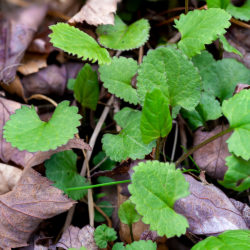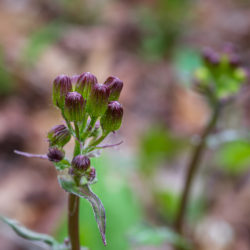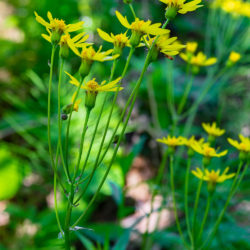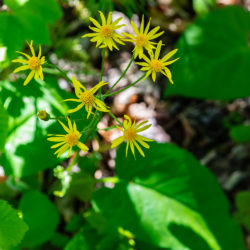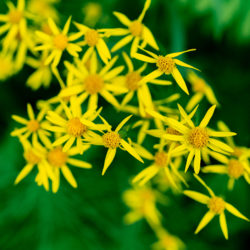Etymology
Packera is Latin for James Packer, a Canadian biosystematist; aurea is Latin for golden.
Native Habitat
Wet meadows, moist open woods and stream banks.
Garden Uses
Lovely in spacious sunny borders or rain gardens and along well-drained water edges (tolerates seasonal flooding). Naturalizes rapidly, with a bright and profuse early summer bloom, and foliage that continues as an attractive ground cover. Seed spreading and appearance can be controlled by removing spent blossoms.
Overview
An attractive, golden-yellow blooming perennial herb that prefers moist, well-drained sunny locations, but will tolerate part-shade and some dryness. Height ranges from 1-2 feet in flower. It spreads easily by both wind-borne seed dispersal and rhizomes, and can naturalize nicely to suppress weeds and offer full-season color from both bloom and attractive foliage. There are 16 North American species of this genus; it is found throughout the eastern US.
Leaves and Stems
Basal foliage of dense, dark green, heart-shaped 4-inch leaves has a purple underside and is semi-evergreen (evergreen in areas of mild winter). Leaves are alternate, lobed, hairless, on slender, purplish stalks 2-4 inches long. Stalks hold the basal leaf blade at an angle or parallel to the ground. Flower stems are 1-2 feet long, smooth and purplish, and usually branch into several stalks. Stem leaves get smaller up the stem, becoming elongated, stalkless, and deeper lobed.
Flowers
Daisy-like, yellow radial petals (7 to 20) form 1-inch blossoms. Petal tips may be tinged in purple. Blooms grow in a flat-topped cluster at the tops of the long, slender, often branched flower stems in May.
Fruit/Seed
A fuzzy spherical plume is formed by the tufts attached to each small brown seed.
Wildlife Associates
Completely deer resistant. Attracts native bees.
Propagation
Stratified seeds or root division in spring.
Ethnobotanical Uses
A traditional medicinal herb, with uses similar to ergot, the leaves of this plant are now categorized as a low severity poison (they contain pyrrolizidine).
Garden Location
Performance Hall Garden (see garden map)
Sources
Lady Bird Johnson Wildflower Center
North Carolina Cooperative Extension Service
Flora of Wisconsin: Consortium of Wisconsin Herbaria
Plant Profile by Kate O’Dell

